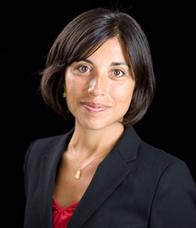In a new book, Mehrsa Baradaran '05 examines class discrepancies in the ability to obtain credit.
In the late 19th century, photojournalist Jacob Riis published How the Other Half Lives, drawing attention to conditions of poverty in the tenements of New York City’s Lower East Side. Mehrsa Baradaran ’05, associate professor at the University of Georgia School of Law, took inspiration from Riis’s work in her new book, How the Other Half Banks, which looks at how unequal credit contributes to the problem of inequality in the United States.
This country has a two-tiered banking system, Baradaran writes: one tier, a highly regulated and subsidized bank industry that caters to the middle and upper classes, and the other, an unregulated and often unscrupulous fringe-banking sector composed of loan sharks, pawn shops, and payday lenders who prey on low-income borrowers. “This contrast isn’t just an economic problem. It’s a social and a political problem that really needs to be addressed for the sake of the democracy,” Baradaran says.
Baradaran’s proposed solution is to bring postal banking back to the United States. Postal banking, which included simple interest-generating savings accounts available at the counter in selected US Post Offices, was established by President William Taft in 1910 and lasted until 1967. Baradaran credits the postal banking system with helping to fund World Wars I and II and assisting the government’s recovery after the Great Depression. A modern postal bank with expanded financial services including small loans, she argues, would enable the portion of the population that is currently unbanked or relying on high-cost fringe loans to have access to credit without crushing interest rates. “There’s really no loss here, except if you’re talking about the payday lending industry or the cash lending industry,” Baradaran says. “And that’s a loss I’m comfortable with.”
This proposal, Baradaran argues, not only benefits low-income populations, but also serves the interests of both the banking sector and the US Post Office. “We have all these rules that make banks go into low income areas and lend, and they’re always fighting these rules,” Baradaran says. The Post Office recently released a white paper making the case for providing financial services to the underserved. These services could, in fact, yield major revenue for the Post Office, which reported a $586 million net loss in the third quarter of 2015. “Let’s let the banks off the hook,” Baradaran says. “Let’s let the Post Office, who wants this work and is capable of doing it, provide these services.”
Following her work on How the Other Half Banks, Baradaran’s next project focuses on the history of black-owned banks, from the post-Civil War period to the present day. “There’s this fascinating history of this sector of banks owned by blacks for blacks. Because of racism and discrimination, they weren’t allowed or welcome at white institutions, and so they created their own financial sector,” Baradaran says.
“Mehrsa has a really unusual perspective on very important issues in financial regulation,” says Geoffrey Miller, Stuyvesant P. Comfort Professor of Law, who taught Baradaran during her time at NYU Law and whom Baradaran cites as a continued source of guidance and support. “I don’t think there’s anyone like her in legal academics.”
As a law student, Baradaran did not originally plan to go into academia. After law school, she worked for three years at Davis, Polk & Wardwell, where she focused on banking regulation. “I was there during the financial crisis,” Baradaran says. “I saw a lot of things firsthand, which was a really instructive experience, and I thought, well, I’ll write a paper about what I saw. And I did that, and then I wrote more, and it’s turned into the perfect career for me—I love teaching and I absolutely love writing.”
Baradaran recalls that Rachel Barkow, Segal Family Professor of Law, who taught her Administrative Law, had encouraged her to go into legal academia. “She saw something in my future that I did not think was a possibility then,” Baradaran says.
“Mehrsa is motivated by a genuine interest in improving the lives of others, which I think can be a terrific motivator for excellent scholarship,” says Barkow. “She is also an incredibly nice person with a great sense of humor, and that has remained a constant throughout her career. It’s been a joy for me to watch her achieve so much.”
Posted November 1, 2015
